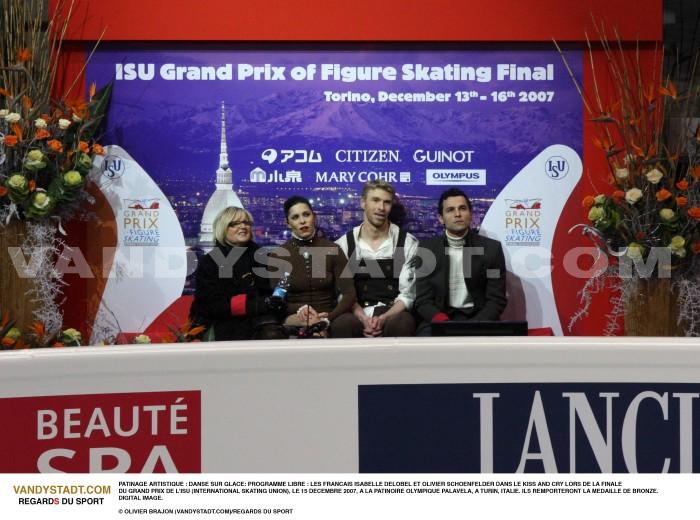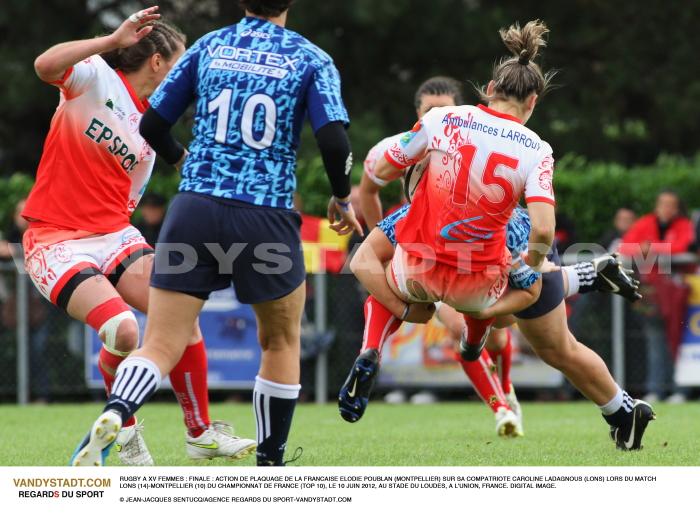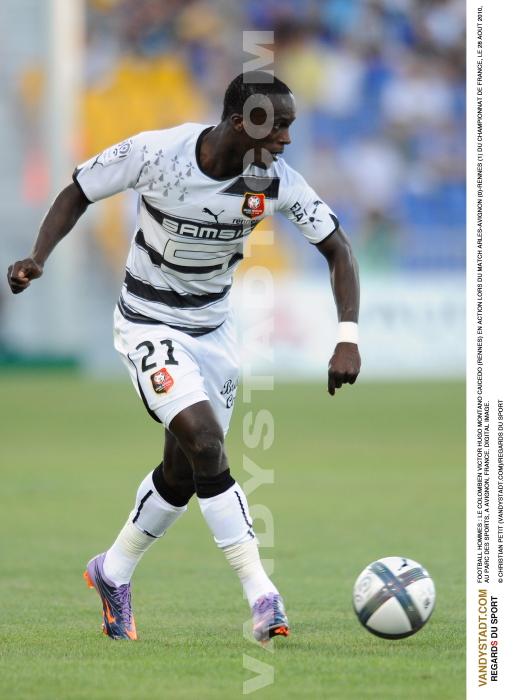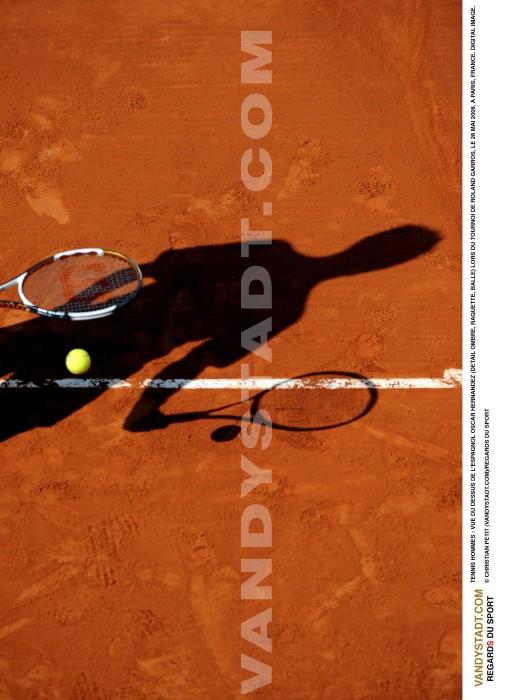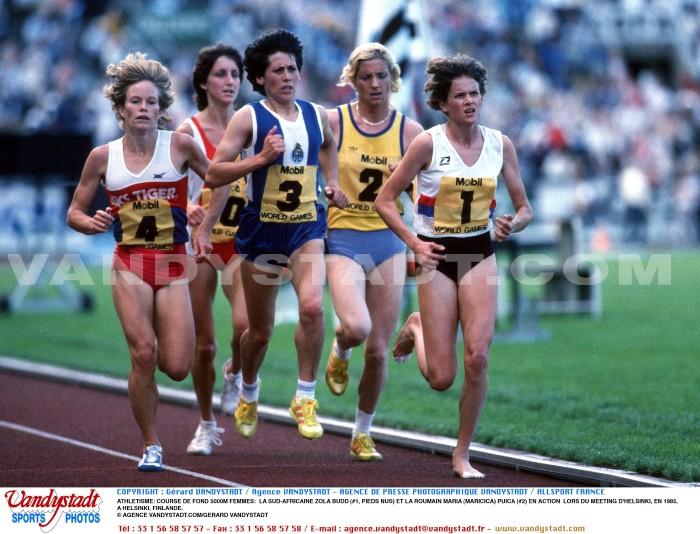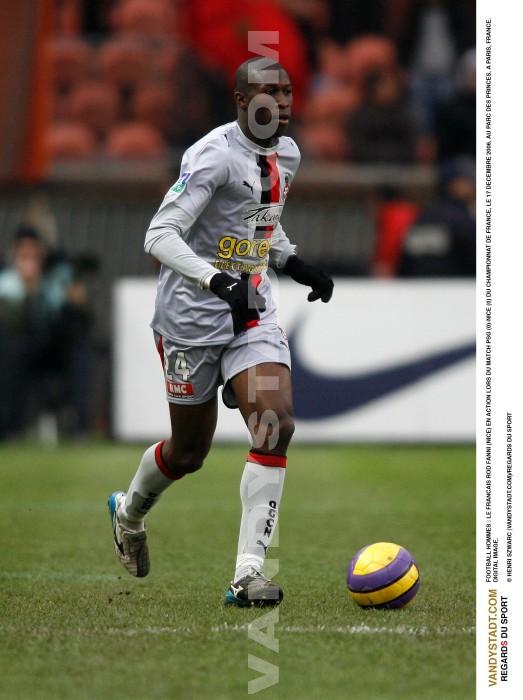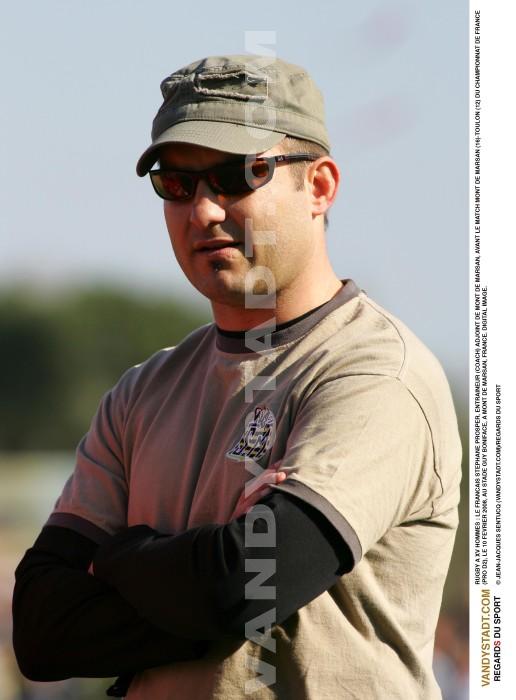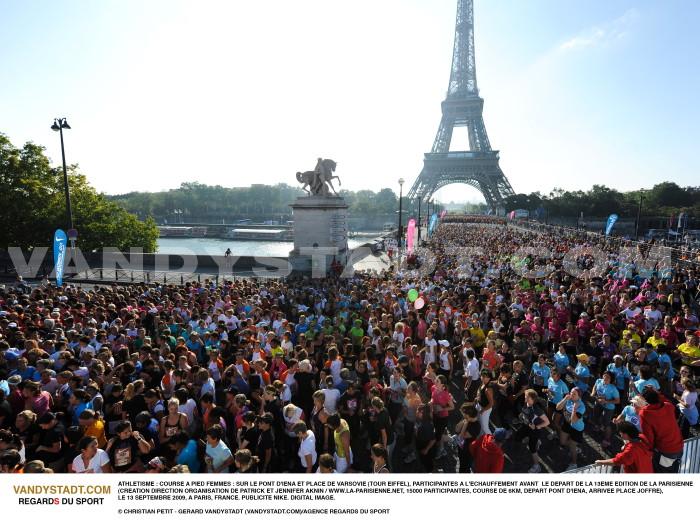Tennis - Tennis history
Tennis - Olympic Sport
![]()
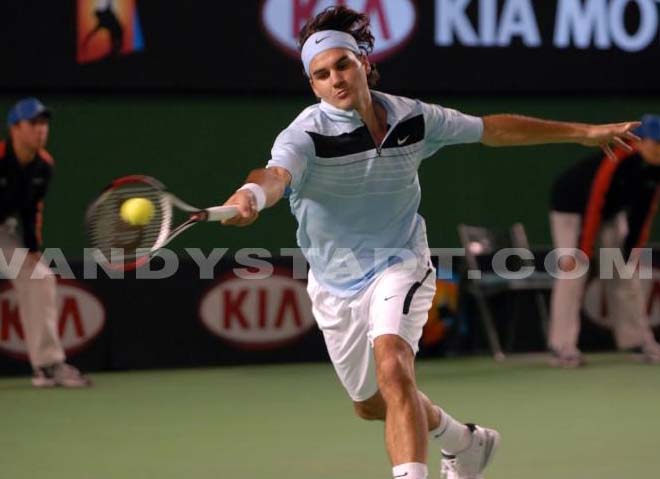
Tenetz, tenes, tennis, Teny, tenyse and tennis ... ..
History
The name of tennis originated from an old French word "tenetz", that when used at tennis the server to tell his opponent that he would initiate. This word has undergone
deformations straps for many years across the Channel as tenes, antennas, tennis, Teny, tenyse, etc.. While it is obvious that the current sports "tennis" certainly originated the game of tennis, French game, whose rules were written in 1592, nothing is certain about the origin of the game of tennis that would find its roots in a series of ball games of antiquity.
The game of tennis was a sport very popular in France until the Revolution. Kings practiced and perhaps to them, Henri IV was a highly respected player on the ground, we must transform the material: a practice first with bare hands, which damages the hands (we then protected them with bandages of linen or leather), then it evolved into webbed gloves, and then to use a bat, weight, pallet dolly, to reach the racket with different coverings such as leather, parchment and finally the rope. After the Revolution, the game of tennis emigrated
Great Britain, they played even a world championship of "Royal Tennis" in London in 1815. This sport is practiced until between four walls.
It certainly Major Walter Clopton Wingfield (1833 -1912) who became the first professional tennis for to get the full rules he had to pay and to receive all the material of his game he called "sphairistike" d a Greek word meaning "ball game". It was probably the first to use the sports advertising through the press.
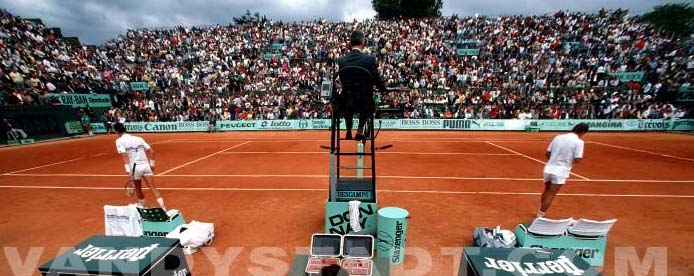
- In 1873, the golf sphairistike was shaped like a bow tie (length 18.30 m, width 9.15 m), closer to 2.40 m in the net bottom line. It was longer than 0.90 m of the ground and the net current high of 1.24 m.
- In 1877, the short, become rectangular, presented exactly its current route in width (8.23 m) and length (23.77 m).
- In 1880, the service area stabilized 6.40 m deep, and in 1890 the net found its final height.
Tennis and its current rules date from the early twentieth century as the ball found its final weight to 1902. A ball at the discretion of time and games, was filled with feathers, sand, animal hair, wool, air, covered with skin, fabric, leather, rubber, and finally, from 1874, a kind of white flannel tried for the first time by a certain John Heathcote.
The International Federation of Lawn Tennis was created in 1913, renamed in 1977 the International Tennis Federation (ITF) and has 191 member countries.
Key dates
Wimbledon 1877 First won by Spencer Gore GBR
First 1882 U.S. Open won by Richard Sears USA
1902 First Australian Open won by Rodney Heath AUS
Roland Garros 1925 First won by René Lacoste FRA
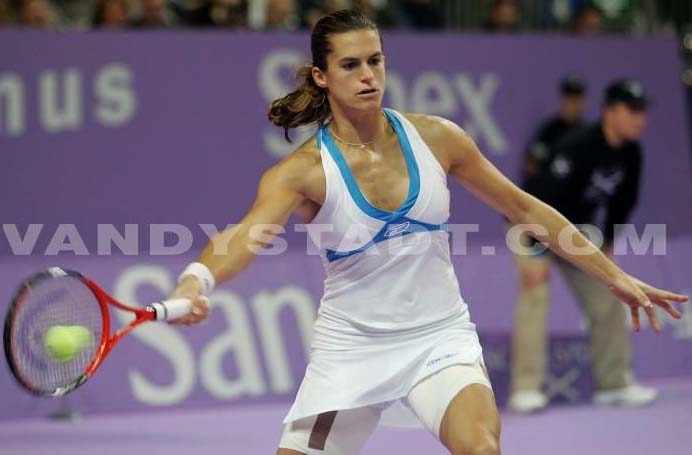
1968 On March 30, the International Federation agrees, after eight years of negotiations, as tennis becomes 'open', meaning that players playing on the circuit parallell could finally play the tournaments included in the calendar of the Federation Internationale.
The first tournament 'Open' takes place in April 1968 in Bournemouth, England. The first Grand Slam 'Open' was Roland Garros, which spanned 100 000 francs (15 000 euro) price in May 2008, beating his compatriot Rod Laver in the finals June 9, Australian Ken Rosewall became the first player to receive a check of a Grand Slam.
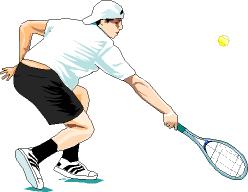
The French Tennis Federation (FFT)
The ancestor of the TFF was established in 1888 within the USFSA (Union of French Societies of Athletic Sports), but it was not until 1920 that means the day the French Federation of Lawn-Tennis, which in 1976 became French Federation of Tennis. This is the first female sport in France and the first sport in
iduel French.
Tennis in France, is also: 1 800 000 games, 8 500 tournaments 380 000 competitors, 280 and 000 players ranked 33 000 short.
Dinard Lawn Tennis Club
The first tennis courts in France and probably one of the oldest in the continent, was built by the English on the Emerald Coast in Dinard les Bains in 1879. The French will be admitted from the 20s. The city acquired the land in 1929 and renamed the club, Tennis Club of the Emerald Coast.
Tennis and the Olympism
Tennis is one of the original sports of the modern Games. He figured the program until 1924, lost its Olympic status, reappeared in 1988 as a demonstration sport. It is again an Olympic sport in its own world since 1988. The Olympic tennis is open to professional players enabling the participation of the greatest players in the world ( Andre Agassi , Graf Seff, etc..). Since 2004, the Olympic women's tournament has for the WTA rankings.
Did you know: the first woman in history became Olympic champion was a tennis player, the Englishwoman Charlotte Cooper, who won gold in singles and mixed in 1900.
Short History:
When Irishman John Boland (1870-1958) came to Athens for the first modern Olympics in 1896, he had no idea he would return home with a gold medal in tennis. Besides, he did not even know that he will participate in a competition, since it went to Greece as a spectator! His friend, Thrasyvaolos Manaos, Member of the Organizing Committee has entered the tennis competition in which he defeated the Greek Dionysios Kasdaglis and thus became the first Olympic tennis champion and that with dress shoes! He won a second gold associated with the German Fritz Traun duplicated.
Competition
Two players or two teams of two players compete on a court by returning the ball with a racket.
Field
Rectangle shape. Length: 23.77 m, width: 8.23 m to 10.97 m and simple to double or 1.37 m over each side for the simple.
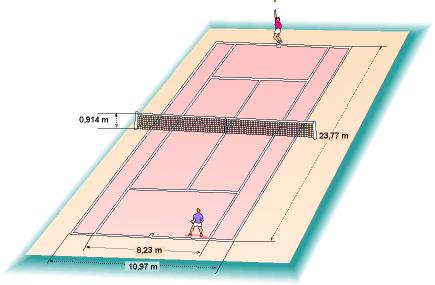
The different surfaces
In the 19th century, tennis was practiced only on an area of sod (hence the original name lawn tennis).
Today, there are:
1 - clay
Red, it consists of a limestone tread, implementation on a foundation draining. The coloring is obtained by adding a layer of gravel. The game promotes rebounds slow and lengthy exchanges. Practice Game: good season.
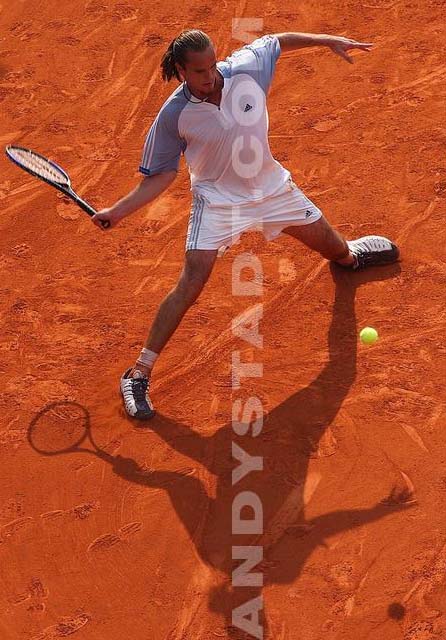
2 - porous concrete
9 inches of concrete as a slab on a foundation draining. It can either be dyed or painted surface. Practice Game: all year.
3 - waterproof resins
Coating layers implemented on a structure of type "highway". Any color. Depending on the choice of pigmentation. Practice Game: all year.
4 - Grass
Not present in its natural form in France, he developed intensely as type "artificial turf". Carpeted with a thickness of 2 inches of sand weighted on durable foundation. Practice Game: all year. Grass favors a fast game.
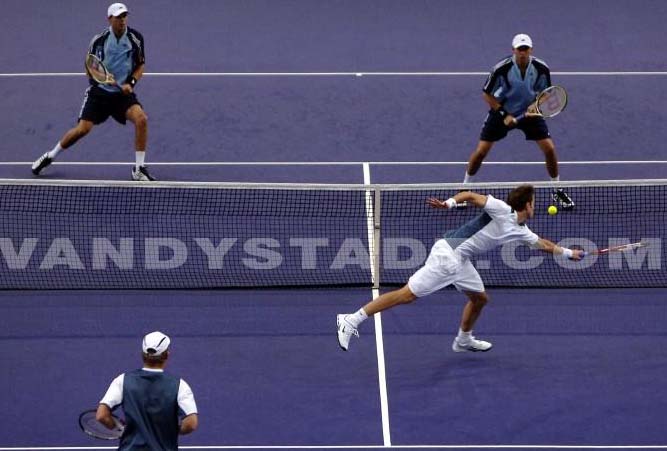
Did you know that the bullets used on lawns are heavier to slow the game and the rigging rackets are more 'active' to give them momentum. Finally, to accentuate the 'trampoline', the voltage is lowered from one to three kilograms.
5 - Miscellaneous
There are also many other processes such as coated waterproof polyurethane coating, PVC carpet, carpet, wood etc..
The net
The height of the net is in the center of 0.914 m and there must be upheld by a completely white strap 5 cm wide at most. The net is supported by stakes of 1.07 m.
Balls
They should be yellow or white, with a diameter of between 6.54 and 7.3 cm (compressed air in the rubber-coated felt), and weighing between 56.0 and 59.49 g.

The racket
They were timber from 1877 until 1970, then metal and since the 1980s, they have a composite oversize frame. Since January 1997, the size of snowshoes for professionals is limited to 73.66 cm or 29 inches (including handle) with a weight of about 280 grams. This applies to fans since January 2000.
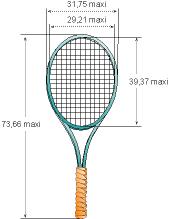
Namely:
The tension rope champions of tennis varies from 25 to 30 kg (mean 28 kg).
A professional player uses 5 to 10 rackets to every tournament 10 to 50 rackets in a season ruined.
The number of points1. When a player wins the first point, there are 15 for a player and when it wins a second point there are 30 for him when a third point is won, the player's score is 40, the fourth point won by gives a player the game except in the following circumstances:
- If both players have each scored 3 points, the score is "equality" and the next point won by a player constitutes a "benefit" to a player;
- If the same player wins the next point, he wins the game;
- If another player who wins the next point, the score is again "equality", the game continues until one player has won two straight points after the equal; a player wins then the game
2. The player who first won six games wins a round, provided it has a lead of two games on its opponent. However, if both players have won all 6 games, shall be decisive in a game ..
The maximum number of rounds in a game is 5 sets for men (on the occasion of the Grand Slam tournaments, the finals of Masters Series or in DavisCup, but in most cases the games are played in three set) and three for women.
Scores
15: Score awarded to a player who has won a point in a game
30: Score given to one who has won two points in a game
40: Score given to that having scored three points in a game
Before 1958, the server must have one foot in contact with the ground. Since 1958, it is permissible to skip the service giving priority to power.
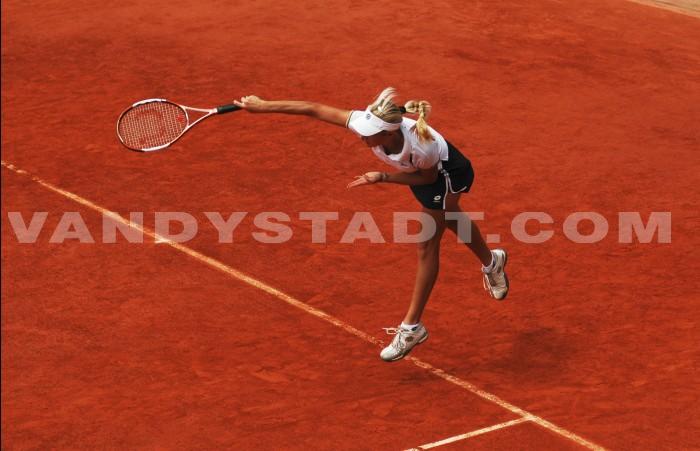
Point lost
A player loses one point:
1. If he does not return the ball directly into play over the net before it hit the ground twice;
2. If he returns the ball and it hits the ground outside the lines limiting the opponent's court;
3. If running a sudden he touches or strikes the ball more than once with his racket;
4. If he himself, his racket (which he held in the hand or not), clothing or any other item that carries touches the net, poles, pickets simple cord or metal cable, strap or tape, or the ground short of the opponent until the ball is in play;
5. If he hits the ball stolen before it crossed the net.
6. If the ball in play touches him or touch any part of his clothing or any object that is, except his racket, whether held in one or both hands.
7. If he throws his racket to the ball and touch.
8. If deliberately change the size of his racket while playing the point
9. if he misses two consecutive service (double fault).
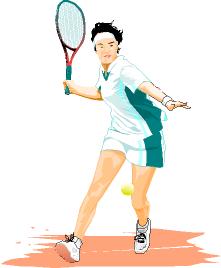
The return is good:
1. If the ball touches the net, poles, pickets simple cord or metal cable, strap or band, provided it is passed over one of them and either fell on the ground Within short;
2. If the ball served or revived, touches the ground within regulatory limits, but short of the returns from the rebound on the other side of the net (beside pitching), and if the player whose turn it is hitting the ball hits it over the net, provided that neither the person nor any part of his clothing or any other item that bears or his racket touching the net, poles, pickets simple, rope or metal cable, strap or band, or the ground short of the opponent, and provided that the coup is also good;
3. If the ball is outside the revived post or picket simple, either above or below the level of the net, even if it touches the pole or stake simple, if it touches the ground in regulatory limits;
4. If a player's racket passes over the net after he returned the ball, provided it has passed the net before being played and has been regularly revived;
5. If a player succeeds in returning a ball or a service ball that hit a ball remained on the court.
The 2 waitresses fastest:
Brenda Schultz-McCarthy NED with 208 km / h at the Cincinnati Open in 2006, Venus Williams USA to 207 km / h at the U.S. Open in 2007.
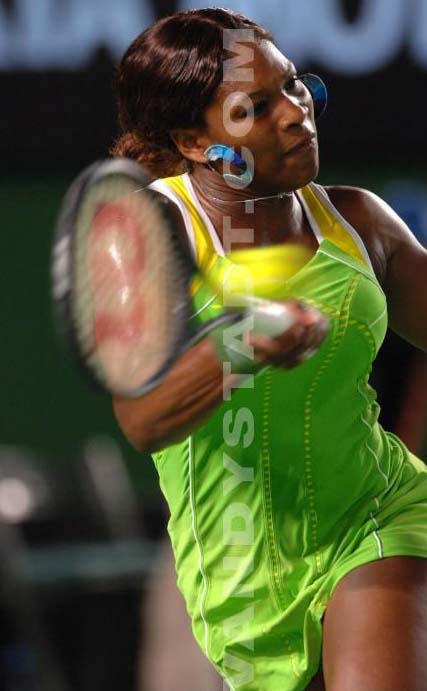
Change of ends
Players change sides at the end of the first and third game and after every odd game in each set and at the end of each set (although the total number of games in the set is even).
If an error occurs and the correct order is not met, players will resume the normal order as soon as the error is discovered.
The game or decisive tie-break (introduced in 1970)
1. General
The tiebreak system will occur when the brand reaches 6 or 8 games all in any one game, except possibly in the third or fifth set of parts respectively provided in three or five innings. This third or fifth round will be played normally with benefits play. The organizing committee will decide and announce before the start of the tournament game or competition, if the tiebreak system will apply to 6 or 8 games everywhere.
2. Singles
- The player that wins the first 7 points win the game and the sleeve, provided it has two points. If the mark is 6 points throughout the game will continue until the difference of 2 points was obtained. The digital brand will be used throughout the tiebreak.
- The player whose turn it will serve the first point. His opponent used the second and third point, and thereafter each player alternately serve two consecutive points until one of them has won the game and the inning.
- From the first point, each service is performed successively from the right side and left side of the court, beginning with the right side.
The players change ends every six points and at the end of the tiebreak. The game will have a decisive game for the change balls.
3. Doubles
In doubles, we apply the simple rule. The player whose turn it will serve the first point. Thereafter, each player will turn two points in the order followed earlier in the round until the game and the sleeve have been won by a team.
4. Change service
The player (or team in the case of two) who served first in the tiebreak will receive service in the first game of the next round.
Most games played in a match:
- 126 games between Single and Roger Taylor GBR Gasiorek Wieslaw POL POL Warsaw in 1966 (27 -29, 31 -29, 6 -4).
- 147 games between Double Dick Leach / Dick Dell USA and Len Schloss / Tom Mazu USA Newport USA in 1967 (3 -6, 49 -47, 22 -20).
The longest match (open era):
- 6 pm 33 between FRA Fabrice Santoro and Arnaud Clement FRA (6 / 7 6 / 7, 6 / 3 6 / 4, 14/12) at Roland Garros in 2004 (old record: 6 h 22 in 1982 during a quarterfinals of the Davis Cup between USA John McEnroe and Mats Wilander SWE)
The game's longest:
- 1 hours and 19 minutes to score a point (3rd item of tie-breaks, ball returned 989 times over the net) and Ricart between Mlle Mlle Marot at Roland Garros in 1981.
Double Game
In doubles, we apply the simple rule. The player whose turn it will serve the first point. Thereafter, each player will turn two points in the order followed earlier in the round until the game and the sleeve have been won by a team.
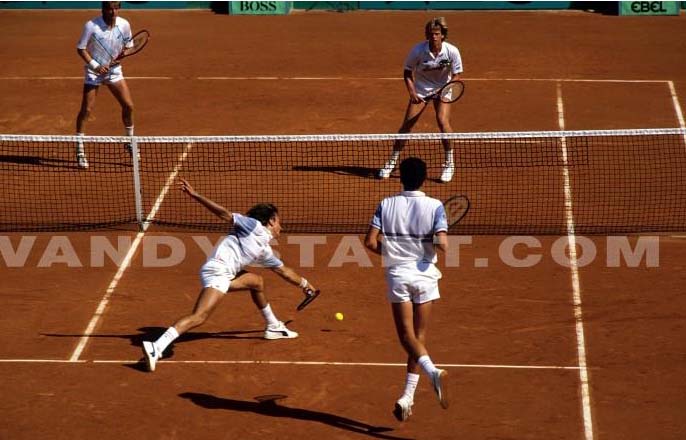
Some differences:
1. For the double play, short measuring 10.97 meters wide, that is to say, 1.37 m over each side for the simple. We play all over the field. The party lines aside short of simple lies between the two service lines is called "line side service.
2. The order of service will be decided at the beginning of each round as follows: the team that first service game of each round means the player will serve the second game partner of the player who served the first game will the third. The partner of the player who served the second game will serve in the fourth and so on for all other games of a round.
3. The order in which the service must be received will be decided at the beginning of each round as follows: the team must receive the service in the first game appoint partners who receive service in each game during the odd round. The opposing team shall from the same partners who will receive the first service in the second game and that partner will continue to receive the first service in all games and peers throughout the round. The partners will receive the service alternately for each game
A super tie-break was introduced in doubles matches since 2006: up 10 points instead of 7 points replacing the decisive third set.
The double, an Australian specialty!
The Australian duo Mark Woodforde and Todd Woodbridge won a record total of 61 victories including 12 Grand Slam titles. Other famous players to double their compatriots Frank Sedgman and Ken McGregor , won the Grand Slam in 1951 and the pair of South Africa Bob Hewitt and Fred McMillan with 57 wins including eight Grand Slam!
A figure
51: the number of aces hit in a single game, a world record that belongs to Swede Joachim Johansson in the Australian Open in 2005 and the Croatian Ivo Karlovic hier at Wimbledon in 2005
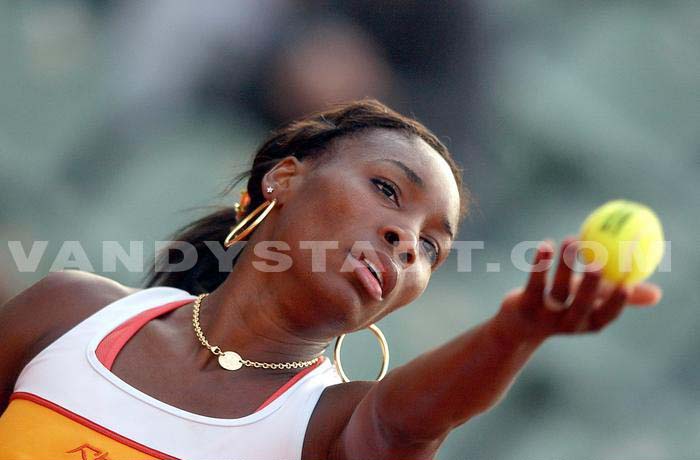
Glossary
Ace: The player scores a point in the service without his opponent to touch the ball.
Acceleration: the player changes the pace of the game by hitting a ball harder or sooner than others.
Cushioning: the player hits the ball more gently so that it falls precipitously just the other side of the net.
Back-court: The area between the service line and baseline.
Before the court: The area between the net and service line.
Advantage: The first point scored after a score of forty-A, or the result of the score.
Ball Sleeve: Point which, if won, can win the round.
Match Point: Point which, if won, will bring victory.
Break: The player wins a game when his opponent is serving.
Square Service: Area short in which a ball must land served.
Choper: The player cuts the ball up and down.
Cut: The player gives a special effect to the ball by moving his racket up and down.
Blow off: Coup in which the ball is struck with the racquet in an oblique position so that the ball loses speed and bounces less.
Coup Cross: knock in the diagonal direction of the court.
Approach shot: Coup sent later in the opponent's court to allow a player to get to the net with the least possible risk.
Coup of the baseline: Coup played after the bounce of the ball, forehand or backhand.
Passing shot: Shoots an opponent who spends going up to the net or is there already.
Forehand: Coup racket in which balls are hit on the right for a right handed player or to the left for a left handed player.
Coup in touch: ball hit so it floats gently.
Short double: The court includes two additional 1.37 m between each row of lateral line simple and double side.
Short simple: Short for singles, not including 1.37 m located between each row of lateral lines and simple double side.
Half-volley: Coup played just after the bounce of the ball.
Double: game between two teams of two people.
Double fault: Second consecutive service failed, causing the loss of point.
Exchange: Exchange of deciding each bullet point.
Retroactively: Opposite effect given to a ball, bouncing backward or stop as quickly as possible.
Gender: At each (points), as in the score "30-equal" or "30-A.
Making the break: Win a game initiated by the opponent.
Failure: Service lost.
Foot fault: misplaced foot Server, punishable by a fault.
Hawk-eye: video system allows the video refereeing. It has been established at the U.S. Open since 2005 and the Australian Open and Wimbledon in 2007
Interception of the ball on the fly: Strategy where the player at the net with a double move on the part of the court his partner to a flight.
Thurs: Part of a round ended when a player or team wins at least four points with two points ahead of his opponent.
Decisive game: A game that decides the winner of a round: the first player or team scoring the first seven points with two point lead wins. Played when the score is tied at six games all.
Let: Service in which the ball hit the net before falling in the permitted area, forced to replay the service.
Lift: Effect forwards gave the ball which is falling sharply, allowing a player to hit the ball with more power.
Bottom line: line that delimits the end of a tennis court.
Service Line: Line connecting the lateral lines of a tennis court, parallel to the net and delimiting the rear of the squares of service.
Tram: Line demarcating the land on the side of a short single or double.
Lateral line simple: line delimiting the surface on one side of the court, located 1.37 m inside each side line double.
Side of double lines: Lines defining the limits of play from both sides of the short, 1.37 m outside the lines simple.
Lob: ball high and short in front of the opponent, usually above the head of the opponent.
Channel: Part of a match completed when one player or team wins at least six games and leads with at least two games away, or has won the tiebreak.
Channel decisive Manche granted, after a tie between two players or teams to six games anywhere, any opponents until one of them take two games ahead
White sleeves: Without losing run.
Match: Part of tennis between two players or teams.
Net: Ball touching the net.
Passing Shot: The player sends the ball low to the net to pass his opponent mounted net.
Winning Point: Point won with the agility of a player rather than the fault of the opponent.
Central position: Make perpendicular representing the middle of the bottom line.
Forty-A: A critical moment of a game when the scores are tied (forty everywhere) and a player or team must score two straight points to win this game
Receiver: Player receiving the service.
Return: Return the ball hit by the enemy, mainly with reference to the return of service.
Reverse: Coup racket in which balls are hit on the left or right handed player on the right for a left handed player.
Service Lifts: Service struck with great effect, producing an overall extra bounce when it hits the ground.
Service required: To serve and win a game
Service fly: To return to fly the return of his opponent, the server goes to the net.
Serve: Put the ball in play
Simple: players facing another player.
Slicer: The player gives an effect of rotation on the ball so that it deviates to the side to bounce.
Smash: Coup powerful above his head.
Stolen: Hitting the ball before the bounce, but without the spike.
Zero: zero score
Good to know
- The fly was invented in 1877 by the first winner of Wimbledon men's singles, Spencer Gore. He went to the net to intercept the ball stolen from his opponents.
- The lob was invented by Frank Hadow second winner of Wimbledon (cons Spencer Gore), who decided to send the ball over his opponent to take him to the back of the court.
- The smash was invented by William Renshaw (seven time winner at Wimbledon) in 1881.
Paddle Tennis
Invented in 1898 by the American Frank Peer Beal, paddle tennis is played by the same rules as tennis on a short cut to two thirds of a normal court with rackets reduced to half of a conventional racket and "full "without rope. In 2006, Gaël Monfils won the major tournament in Las Vegas battanrt the big star, Scott Freedman, winner of 185 tournaments (19 times world champion in singles, doubles 16 times and 14 times in mixed doubles!).
Copyright Sportquick/Promedi








